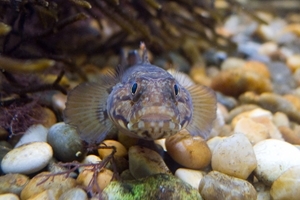The shanny
 For me, the month of August somehow always conjures up thoughts of the seaside, as my parents used to pack the family (plus numerous dogs) into an old Bedford van for the long over-night trip from Worcestershire down to Cornwall. We would celebrate arriving in the county by stopping for a large cooked breakfast, before continuing on down to Polzeath on the north coast (a journey that took around 8 hours to complete!) for our annual three-week holiday.
For me, the month of August somehow always conjures up thoughts of the seaside, as my parents used to pack the family (plus numerous dogs) into an old Bedford van for the long over-night trip from Worcestershire down to Cornwall. We would celebrate arriving in the county by stopping for a large cooked breakfast, before continuing on down to Polzeath on the north coast (a journey that took around 8 hours to complete!) for our annual three-week holiday.
Usually, before we had even unpacked properly, I had disappeared down to the rocky coastline, net and line in hand, to reacquaint myself with my favourite rock pools. I always remember feeling so relieved that they were exactly as I had left them the previous August, and never ever lost that excited feeling of peering down into this beautiful world of reds, greens and yellows to see what I could spot. I still love these same pools, although they now seem so much smaller than they did when I was a young lad!
I spent literally hours and hours dipping into these rock pools, catching a wide assortment of ‘water life’ and placing them all into a large yellow bucket so that a grown up could be shown the catch at some later stage. I once caught a good sized mackerel from a deep little pool, which my mother later cooked me for supper!
But my favourite catch of all was always the feisty little fish called a shanny (Lipophrys pholis), sometimes also known as a common blenny or sea-frog. The shanny can grow up to six inches long (although most I caught were much smaller than that) and has a massive, blunt head with eyes set high and large jaws, which then tapers away to an afterthought of a body. There is a series of blotchy marks along the body, offering differing shades of brown and green, the colouration changing depending on the background on which the fish is lying.
The shanny is distinguishable from all other UK blennies, the family to which it belongs, by the absence of paired tentacles above the eyes. It is a common species and is found right around our shores in rocky areas in the intertidal zone. When the tide goes out, the shanny is not that fussed and will stay put, taking refuge in a rock pool until the tide comes back in.
Should there not be a convenient pool to utilise, then this little fish will quite happily hide in a crack or crevice, under a rock or within a clump of seaweed. The lack of water is not an issue for this species as – provided the environment is damp and moist – it is capable of living out of water for many hours. Indeed, sometimes they can be seen making their way across seaweed or between rocks, using their large pectoral fins just like webbed feet to propel them along! It is this behaviour that has lead to its alternative name of the sea frog - truly a fish out of water!
Shanny can spend time feeding in a freshwater stream as it enters the sea and adapt, literally within minutes, to living in salt water again once the tide comes back in. Some other fish such as flounder have the ability to feed in brackish waters and can adapt between salt and mixed salt/fresh water relatively quickly, but certainly not as fast as the Shanny can change between fresh and salt water. Migratory fish such as salmon can take a few days to fully adapt physically to the change from salt to fresh water.
Although navigation is common in many animals, only a few perform true navigation, meaning that they have the ability to return to a given place through the so called 'map and compass' mechanism. The shanny is thought to have homing abilities through a mechanism that primarily makes use of familiar landmarks (i.e., piloting). Anecdotal reports, followed by recent research appears to show that individuals can indeed return to their home pools after release at unfamiliar sites, suggesting that this little fish might use cues collected at the release site to find their way back.
The shanny has become a new ‘lookout’ species for pollution monitoring, as it combines many characteristics required in a sentinel species. It is abundant and easy to catch, has a wide geographical distribution and restricted intertidal home range, and they remain in the same area for the whole of their life-cycle, thus reflecting local pollutants exposure.
Shanny have very sharp teeth, which coupled with powerful jaws, are used for crushing barnacles (the main diet), small crabs and any other little creatures that happen to pass too close. I used to catch them with whatever my mother had filled my sandwiches with – they never seemed that fussy! A word of warning though – be careful if you handle them – they don’t think twice before giving you a painful nip!
So bold they are – but big they are not! The British shore caught record is a mere three ounces & 15 drams, caught by M. Carter, Poldhu Cove, near the Lizard, Cornwall in 1995. Ah bless!
Peter Thompson
Advisory
Read more from Peter Thompson at the Fresh from the Field blog.
Image © Ian Keith, used under the terms of the Creative Commons licence.